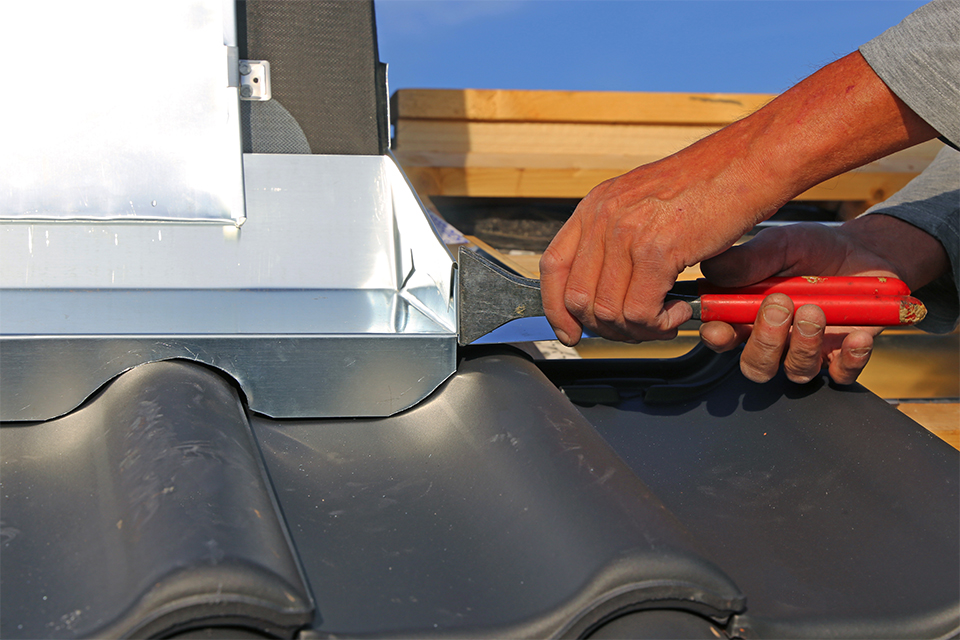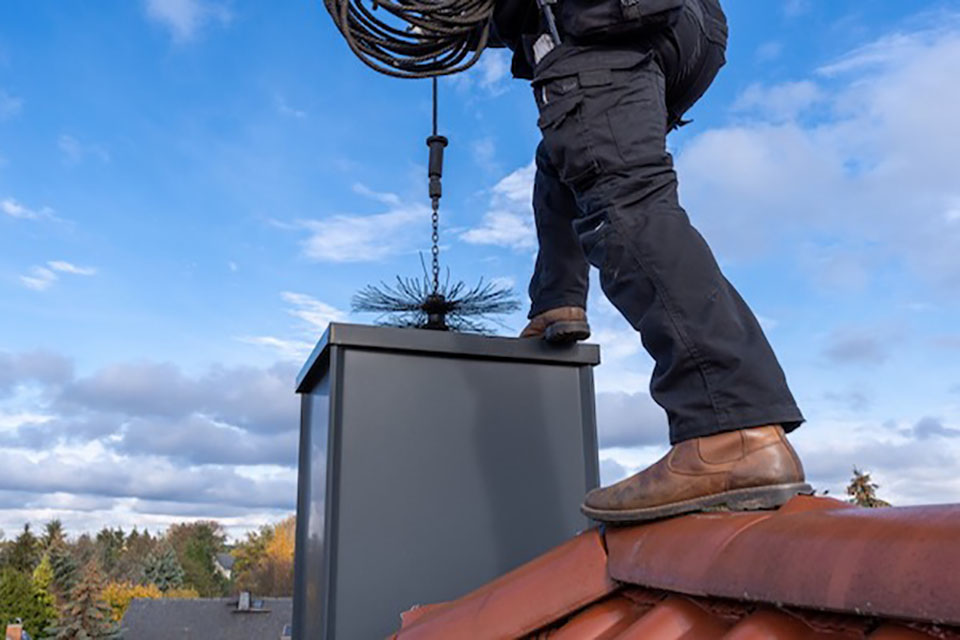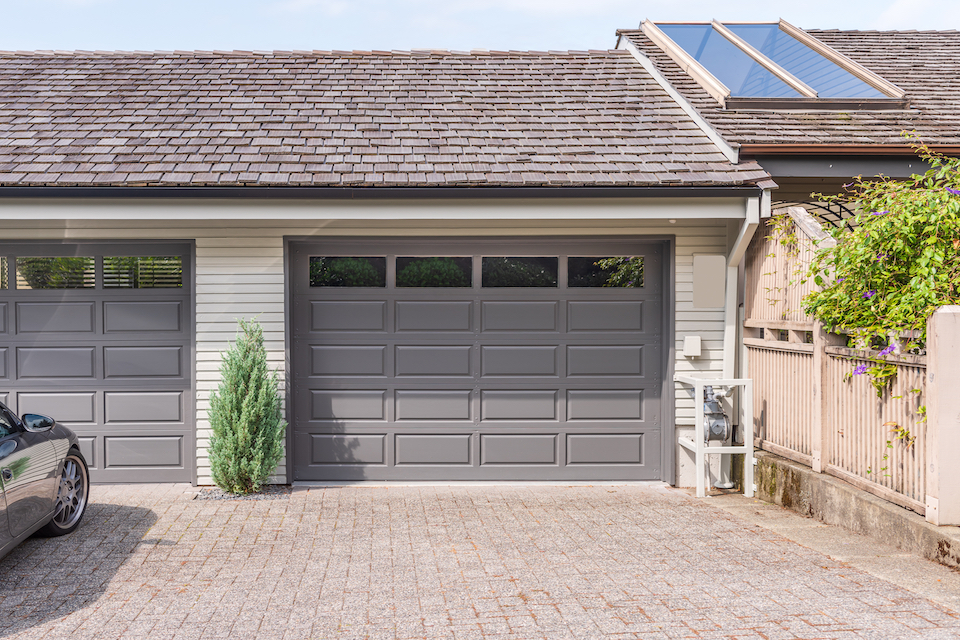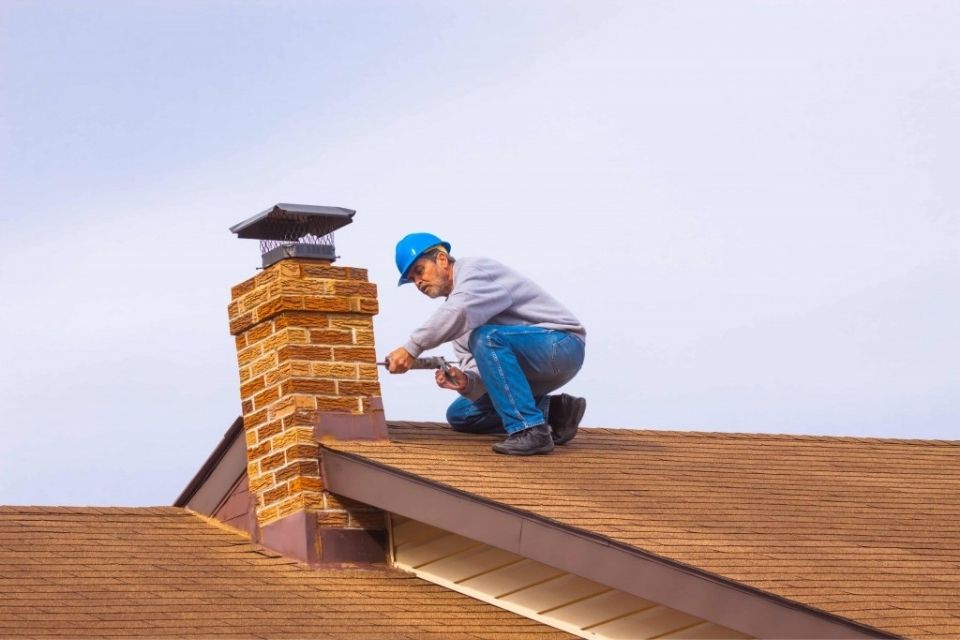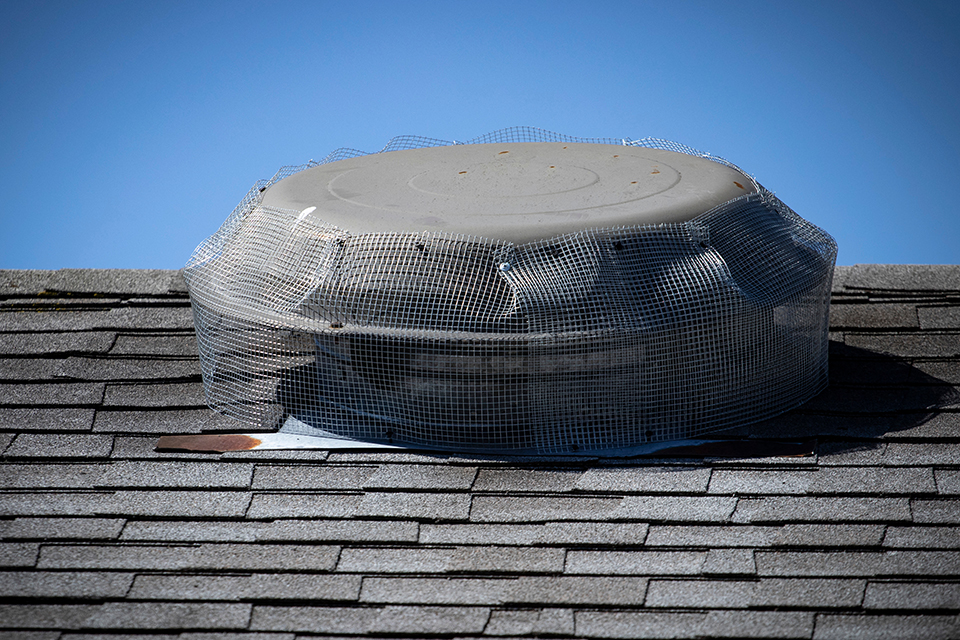How Much Does Chimney Lead Flashing Cost?
A chimney has many different components, all of which play an important role in how well it performs.
Your home's safety is jeopardised if a portion of your chimney is broken, completely broken, or simply missing. The flashing of a chimney is no exception.
People frequently discuss tuckpointing, chimney sweeping, chimney liners, and other chimney services, but flashing frequently goes unnoticed. However, chimney flashing is a critical component of your chimney's functionality.
In this guide, we will go over how long it takes to repair chimney flashing, the different types, and the cost to remove chimney flashing. So, if you need your chimney flashing repaired, you will find everything you need to know here!
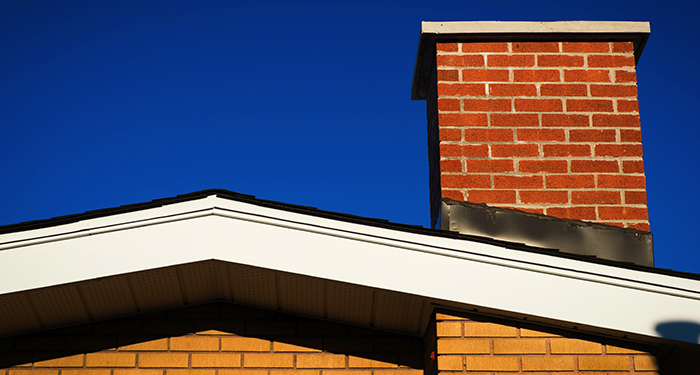
If you have moved into your new home or haven't worked on your existing chimney in a long time, you should look for signs of flawed chimney flashing. Chimney flashing is the main cause of chimney leaks and, therefore, can lead to major problems if not addressed immediately.
Failure of chimney flashing can cause damage to your roof and attic. You should not take roof damage lightly, so if you start noticing any damage, you should contact a roofing company right away to have it repaired. Not to mention that poor flashing can cause significant water damage to your actual chimney.
If enough water rushes into your chimney, the mortar and brick joints will become brittle, threatening the structural integrity of the entire structure.
You should have your chimney inspected at least once a year to prevent this from happening. It is always best to be safe than sorry. Repairing minor flashing damage is preferable to having to replace your roof and chimney due to water damage.
The lead flashing around a chimney protects the overall roof structure from the elements by keeping the rain out of the vulnerable area of the roof where the chimney meets the tiles.
Good lead flashing should last decades, but if it is not properly installed or is too thin, it can break easily or crack, causing larger problems.
The cost to replace all four aspects of flashing (the apron, step flashing, and back box) is about £450 to £600 for materials and labour - but this is the cost if no scaffolding is used.
If it is required, as it is frequently with chimney jobs, particularly on two-story homes, the cost could be up to £500 higher, implying that a typical cost to replace lead flashing on a chimney is between £900 - £1100.
If you are purely trying to fix the flashing with a new section or sealing up cracks, the repairs themselves can cost between £200-£300, but the cost of scaffolding will increase this.
A well-installed chimney or roof flashing could last up to 30 years. Lifespan is determined by environmental factors such as where you live, the size and shape of your chimney, and the materials used to construct it.
Knowing the year your house was built can help you keep track of how long your chimney will last.
The following are indications that it's time to repair your chimney flashing:
- Leaking from the chimney's interior or exterior
- Dripping sounds and evidence, such as puddles
- Bricks that are discoloured
- Stains caused by rust
- Interior water stains on the ceilings or walls adjacent to the chimney
- Gaps in the sealant around the flashing are visible
When it comes to leaks, one thing to remember is that if you notice water inside your firebox, it may not be a chimney flashing problem; instead, it could be a chimney cap problem.
Because of the location of most chimneys, you may not realise water damage once it has pierced further into your roofing. If the roof flashing is damaged, there may be continuous moisture in your loft or ceiling, which can cause wood rot as well as drywall damage.
Chimney Flashing Repair Prices
The table below will break down the average costs of repairing chimney flashing:
| Type of Repair | Chimney Flashing Cost |
|---|---|
| Replace all four aspects of flashing | £450 - £600 |
| Scaffolding for two storey homes | £300 - £400 |
| Replace lead flashing | From £800 |
| Sealing up cracks | £200 - £300 |
- How Much Does Chimney Lead Flashing Cost?
- Chimney Flashing Repair Prices
- Supply Costs for Chimney Flashing Repairs
- Additional Chimney Flashing Repair Costs
- What Impacts Chimney Flashing Repair Costs
- Labour Cost to Repair Chimney Flashing
- Repair Times for Chimney Flashing Jobs
- Types of Chimney Flashing Repairs
- Chimney Flashing Removal Cost
- FAQs
Supply Costs for Chimney Flashing Repairs
Here we will go through the cost of the materials needed to go ahead with a chimney flashing repair job.
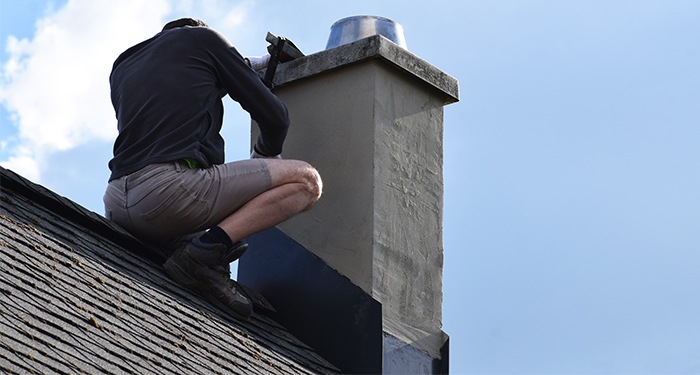
Before you buy the materials for a chimney flashing repair, you should bear in mind and consider the following before starting the job.
Precautions for Safety
To gain access to your roof, you will need to use a secure extension ladder or scaffolding.
Homeowners falling off their roofs happen more frequently than you might think.
When removing the old flashing, extreme caution must be taken to avoid being cut or wounded by the old and potentially very sharp pieces of metal sheet.
You will also need all the necessary equipment and materials to repair your flashing properly, including:
- Protective Eyewear
- Bulky Gloves
- Gripping Boots
A roof jack should be installed in most cases for extra safety.
Considerations for Tools and Materials
You'll also need all of the right materials in addition to the right tools. To cut the flashing correctly, you should take accurate chimney measurements. Before climbing over onto the roof to begin the installation process, the metal must be measured, cut, and bent.
Professional roofers have the proper tools, safety gear, and experience to handle chimney flashing replacements efficiently and without unnecessary risk.
Considerations for Time
There is only so much time in a day to complete chimney flashing work so planning the work is important. Here is a simple guide to the jobs and processes that will be followed to repair chimney flashing:
When To Start
Work should begin early in the morning before the sun has had a chance to heat up the roof. In hot weather, shingles and adhesive heat up and become more flexible and mouldable, making them more difficult to remove.
Roof Protection Whilst Working
Once the shingles have been removed, your roof is exposed and can be damaged, so working in a timely manner is key to make sure it is not uncovered for long.
Fixing Small Holes in the Flashing
Small holes or corrosion spots in flashing can be repaired easily without replacing the whole flashing. Pinholes can be plugged with roofing cement which costs between £9 - £16.
For holes up to 3/4 inch in diameter, these can be patched using the same material as the flashing.
- Use a wire brush or sandpaper to clean the area.
- Cut a metal patch to fit.
- Stick it on with roofing cement.
- Cover it again with more cement.
Sealing Around the Chimney
To renew the seals around the chimney, the old mortar and caulk will need to be removed along the flashing corners. The joints between the flashing and the chimney will need to be resealed using masonry caulk which costs between £5 - £7.
Working with Valley and Step Flashing
Urethane roofing cement or silicone caulk, costing between £6 – £14, will be used to seal the seam between the cap and the step flashing.
If working with valley flashing, this will need to be gently lifted near the shingles and roof cement spread on the flashing, about 6 inches in from the edge of the shingles.
For step flashing, which is used at roof corners, all seams will need to be sealed with urethane caulk.
If drip edges are being resealed, sealant will be applied under the shingles, but not along the edge (eaves).
Replacing Vent Pipe Flashing
To replace the flashing all-around vent pipe, the following steps will be followed:
- Shingles removed behind and beside the vent pipe.
- Old flashing and nails pulled out.
- New vent-pipe flashing put over the pipe.
- Pressed in place and nailed down where shingles will cover it.
- Shingles replaced and nail heads covered with roofing cement.
The table below will break down the supply costs to repair a chimney flashing:
| Supply | Cost |
|---|---|
| Roofing cement | £10 - £18 |
| Stiff brush | £4 - £10 |
| Silicone caulking compound | £7 - £15 |
| Vent-pipe | £18 - £25 |
Additional Chimney Flashing Repair Costs
When repairing chimney flashing, you may decide or need to have other repairs on your home, or other costs may become involved and increase the cost of your repair. Here, we will go through the different additional costs that may be added to the cost of repairing chimney flashing.
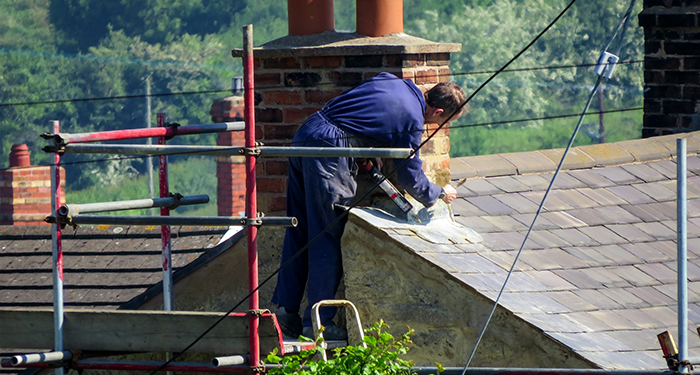
Roof Repair
Once work begins on your chimney, you may find there are other issues that need to be dealt with on the adjoining roof. The cost of roof repairs can vary greatly based on the type and extent of the damage, roof size, and structure.
Roof repairs can consist of jobs such as:
- Ridge Tile Replacement
- Repairing Leaks
- Chimney Repointing
- Structural Repairs
If working on tall buildings, this may require more scaffolding, increasing access costs. Complex roofs with features like dormers or multiple levels can also raise labour time and expenses.
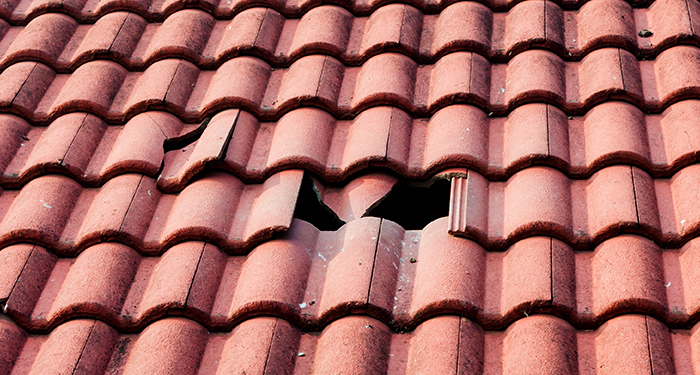
If repairs span several days, a temporary weather cover may also be needed, again adding an additional charge.
Keep in mind that your location in the UK will affect your cost. Most cities, such as London, will have higher labour costs compared to smaller towns.
Depending on where you live, labour costs alone can range from £180 to £280 per day per worker.
Roof Cleaning
Once you have your chimney and roof repaired, you may wish to get it cleaned whilst you have use of the scaffolding. Roof cleaning typically costs between £8 and £12 per m2 which includes labour, equipment and material costs.
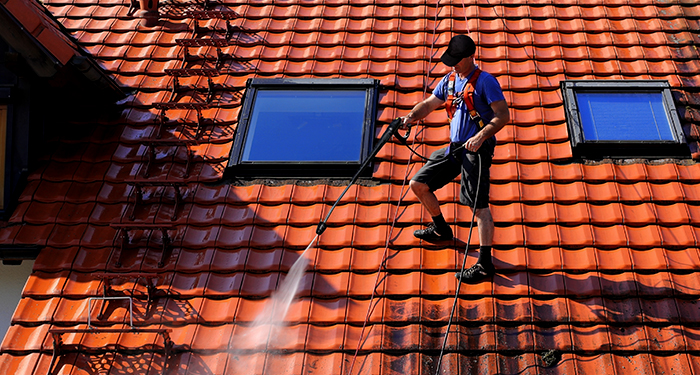
Typical Roof Sizes & Costs
- A terraced roof will be 50-60 square metres: £400 to £720
- A semi-detached roof will be 65-75 square metres: £520 to £900
- A detached home will be 100-115 square metres: £800 to £1380
Larger roofs may also require the use of two people to finish the work promptly, which will reflect in the labour cost.
What Impacts Chimney Flashing Repair Costs
When determining the total price of any chimney repair job, you must consider several factors. We'll look at a few of the most common types below.
Scaffolding Hire
Because the roofer or builder would need access to your roof to finish the work, the ease of access will factor into the final cost of chimney repairs. Any difficulty getting to a chimney could raise the overall cost.
Chimney repairs frequently necessitate the use of a scaffold on your property.
Suppose your chimney is in an especially difficult-to-reach area of your roof, and much more scaffolding needs to be introduced onsite or kept up on your property for an extended period. In that case, the overall cost of the job may rise.
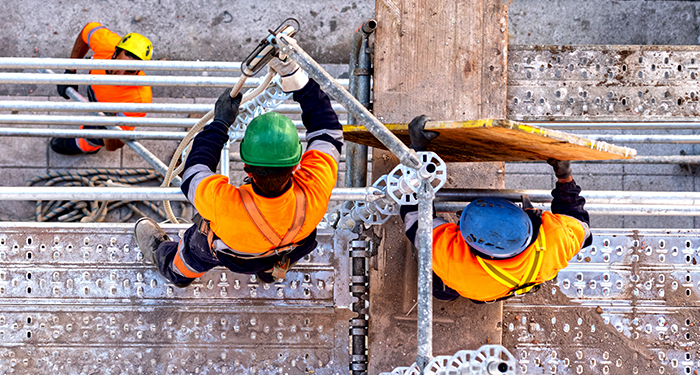
Some roofers would then bring their own scaffolding to the job site and include the cost of the scaffolding in the final cost, but if your roof is notably challenging to access, there may be an additional charge for any extra scaffolding required.
The form and size of the scaffolding, the number of tradespeople employed, ease of access, and the place of your property are all cost-influencing factors when hiring scaffolding. The average cost to hire scaffolding for this type of job will be £450 to £550.
Size
It comes as no surprise that the bigger the chimney, the pricier the repair. This is because a larger chimney will have higher labour and supply costs than a smaller one.
Your Location
Your location in the United Kingdom will determine the cost of repairing chimney flashing. This service will be more expensive in larger cities like London and in the southeast due to higher business and living costs.
To get an idea of the average costs in your area, it is recommended to get three or four quotes from nearby chimney repair companies to compare.
Minimum Fee
When hiring professionals to repair chimney flashing, it’s important to be aware that many contractors or labourers apply a minimum fee for their services. This fee is often a base rate charged to cover the time, travel, and operational costs associated with smaller or shorter jobs.
Even if your repair is relatively quick and straightforward, it may still fall under the contractor’s minimum charge. This could range from a fixed amount to the cost of a full hour or day of labour, depending on the company’s pricing structure.
If you quote states you will be charged by the day, it wouldn't matter if it took a day and four hours or even a day and seven hours, because you'd be charged for two days of work.
To avoid surprises, always clarify the minimum fee and the billing structure before hiring a contractor.
Duration
The longer it takes to fix your chimney flashing, the more you’ll pay for labour. Some jobs only take a couple of days, while other, bigger projects might last several weeks. The more time the workers need, the higher the overall cost will be.
Labour Cost to Repair Chimney Flashing
Chimney flashing repairs often require a skilled tradesperson, like a roofer or builder, because chimneys have complex shapes that need experience and the right tools to work on safely and correctly.
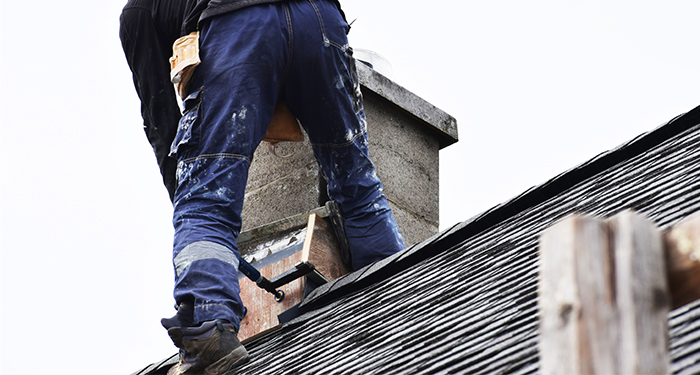
If you spot damp patches near your chimney, on ceilings or walls, it usually means there’s a leak. A professional can check if the issue is with the flashing, where the chimney meets the roof, which is a common problem.
Most leaks happen when the flashing is old, cracked, or poorly fitted. While some people try using cheaper materials like mortar instead of lead, tradesmen know that lead flashing is more reliable and long-lasting.
That’s why professionals will usually recommend removing old flashing and replacing it with new leadwork, installed in a stepped pattern for better waterproofing. They’ll also seal it properly with fresh mortar.
Hiring a tradesman for this job typically costs between £150 and £250 per day. Depending on the size and difficulty of the repair, some may offer a fixed price instead of charging by the day. An experienced roofer will be able to assess the job and give you a clear quote before starting.
Getting the job done by a qualified professional means better results and long-term protection for your home.
Repair Times for Chimney Flashing Jobs
Repairing or substituting chimney flashing is sometimes a time-consuming and labour-intensive process. And it's critical that experts install chimney flashing correctly, or your home may be vulnerable to additional water damage.
How long would it take to fix a chimney flashing, though?
A repair chimney flashing usually takes about a day to complete; however, various factors can influence this and cause the process to take longer or shorter.
Scaffolding (if necessary) takes two to six hours on average to set up, while the actual leadwork replacement should take three to five hours.
The timeframe is determined by the ease of access, the condition of the work area, and the weather conditions. The cost of labour will also vary depending on where you live. A single person has a finite amount of time to work on replacing their own chimney flashing.
Work should begin early in the morning before the sun has had a chance to cook your roof all day. Shingles and sealants heat up in hot weather and are more flexible and mouldable, making them more difficult to remove. If you are not used to the heat, it may be challenging to work in.
Once the shingles have been removed, bear in mind that the longer your roof goes without shingles and roof flashing while you work on the repairs, the more vulnerable it is to damage.
Types of Chimney Flashing Repairs
Chimney flashing would then help keep water out of the chimney. One of the most common causes of leaks is faulty or improperly installed flashing.
There are numerous types of flashing available. The place you live in, the weather conditions, the size and shape of the chimney, and the roofing material all contribute to deciding the best form of flashing for your chimney.
In this section, we will discuss the various forms of chimney flashing repairs, as well as their benefits and drawbacks.
Aluminium Flashing
One of the most popular types of flashing is aluminium flashing. It is reasonably priced and can be installed on just about any type of roof. Aluminium corrodes easily, especially when installed in places with treated shingles or lumber.
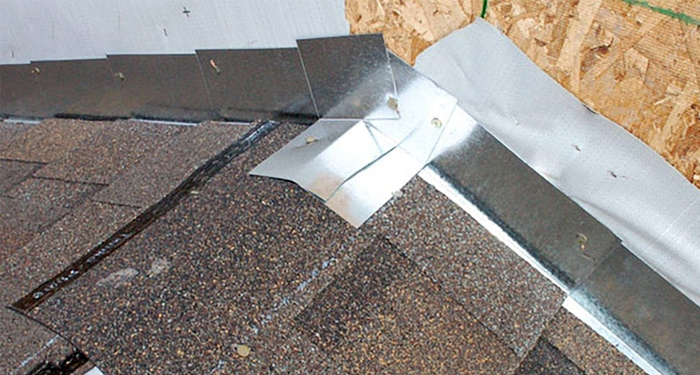
While CCA-treated roofing is uncommon, it does exist. If it is exposed to this, the aluminium will corrode as well as fail quickly. This type of flashing is available in large rolls and can be bent and cut to fit any shape. This makes it an excellent choice for contractors because it is inexpensive to buy in bulk while remaining effective.
Pros
- Popular choice
- It can bend and cut to fit any shape
- Affordable
Cons
- If exposed to CCA roofing, it will corrode
Vinyl Flashing
Vinyl flashing is a lightweight material which costs slightly more than aluminium. Although lightweight, it is not the best material for chimneys, but it can be used in areas without harsh weather.
Vinyl can become brittle and crack or break, making it an unsuitable material for areas having a lot of wet or humid weather. Vinyl is not the best material for withstanding high temperatures, which is why it is not commonly used in chimneys.
Pros
- Lightweight
- Good for areas with wet or humid weather
Cons
- No good for hot countries
Steel Flashing
Steel is a bit bulky and is frequently used in the construction of roofs and chimneys. It is one of the longest-lasting flashing materials. Steel does not corrode as easily as other flashing materials
.Most steel flashing is zinc-coated, and this can corrode even before steel itself. It takes more time because the material is heavier and requires more installation. Because it is more expensive, it is not typically used for entire roof applications, but it is ideal for chimneys.
Pros
- Doesn’t corrode easy
- Long-lasting
Cons
- Expensive
Copper Flashing
Copper flashing has become one of the best materials for chimney or roof flashing available. It is lightweight, resistant to breaking or cracking, and resistant to high temperatures and weather extremes. Copper is one of the costliest metals to work with. Many people may find it prohibitively expensive.
Copper must be installed with a sealant designed specifically for this material. This sealant will provide an additional barrier of protection against water seepage. Copper is also difficult to shape, making it unsuitable for use on chimneys with rounded or difficult angles.
Pros
- Best material
Cons
- Expensive
- Difficult to shape
Chimney Flashing Removal Cost
A well-installed chimney or roof flashing can last for up to 30 years. Lifespan is determined by environmental factors such as where you live, the shape and size of your chimney, and the materials used to construct it.
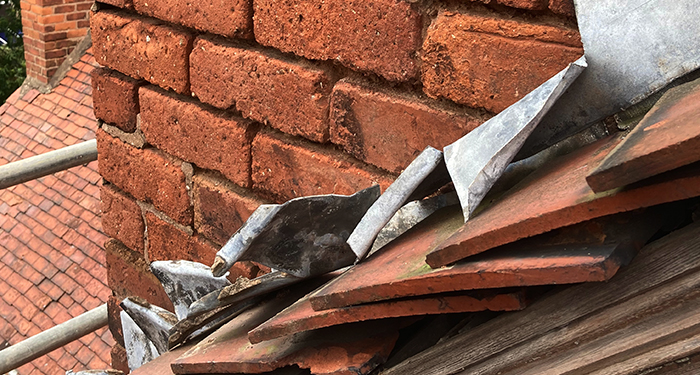
Knowing the year your house was built can help you keep track of how long your chimney will last.
Occasionally, your chimney flashing repair has progressed too far and must be removed and replaced. If you need to replace your flashing, the cost can range from £750 to £1450, depending on the size of the chimney, chimney form, flashing material, and roof type.
As soon as you realise your flashing needs to be replaced, you must address the issue. Ignoring broken chimney flashing can result in additional roofing damage.
FAQs
Q: How do I know when chimney flashing needs repairing?
- A: Failing Mortar Joints: Moisture can enter the chimney when the mortar joints begin to disintegrate. This can cause small flaws to grow much larger, potentially resulting in a chimney collapse
- Water gets into the brick or stone of the chimney because of spalling. This can cause it to enlarge and separate from the stone or brick
- Rust: If you start noticing that the damper is becoming more difficult to adjust or simply will not seal properly, you should inspect it to see if it is rusted
- Ruined Walls: Inspect the walls near the chimney on each level on a regular basis. It's also a smart idea to inspect after heavy rain
- If there is excessive moisture inside the chimney, it can cause damage to the wallpaper or paint
- Discolouration: If it is becoming slight discolouration, it is most likely due to a problem. You should consult with a professional. They will be able to quickly diagnose the problem and inform you of the necessary repairs
- Shaling is a problem if your chimney is older and has a tiled flue lining
- Cracks in the Chimney Crown: It's a good idea to investigate your chimney crown at least two times a year to catch any possible harm early on
Q: Should a chimney have flashing on it?
A: You may well not think chimney flashing is necessary, but it is an essential part of any chimney construction.
If you didn't have chimney flashing, you'd soon notice rainwater dripping into your attic or damp spots making an appearance on your ceiling, walls, or chimney breast.
Q: What is the best flashing for a chimney?
A: Aluminium is a popular material. Aluminium flashing is cheap and easy to install on any type of roof. It is also rust-resistant. Steel – Steel is another popular material for chimney flashing.
Q: Should chimney flashing be replaced with a new roof?
A: Typically, when reroofing, it is best to replace all flashing. Old flashing may start to fail first before the life of the new roof is up. On the other hand, there are a few circumstances in which we may opt to reuse flashing.
Q: How do you seal flashing?
A: Chip out the old mortar and caulk along the edges of the flashing to renew the seals. Enclose the joints between both the flashing as well as the chimney with masonry caulk.
Urethane roofing concretes or silicone caulking composite should be used to seal the seam between the cap and the step flashing.

